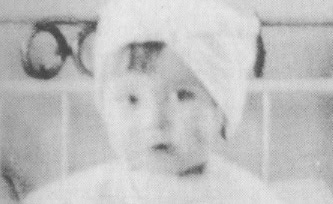Twenty-three month old Annie Liggins was sleeping in her Halifax home on the morning of December 6, 1917. All of a sudden, her mother and brother rushed to the window after hearing an explosion coming from Halifax Harbour and saw thick black smoke rising into the air. An ear-popping blast shook the house, shattering the windows and sending the mother and brother flying, killing them instantly. Baby Annie was thrown as well; then all went silent.
Down at the harbour, two ships, the Norwegian Imo and the French Mont Blanc, had collided, the latter carrying explosives intended for the battlefield in Europe. The Mont Blanc's crew, aware of the impending danger, managed to abandon ship and reach safety on the far shore at Dartmouth. However, many Haligonians stayed at the harbour, watching in fascination as the ship burned, not knowing what was about to happen. Within minutes, the ship exploded, sending a 5 kilometre high mushroom cloud into the atmosphere, the explosion having the impact of 3 kilotons (the Hiroshima bomb had 15 kilotons). The force of the blast and the subsequent tsunami shattered windows, flattened buildings, snapped trees and ground vessels. The explosion was heard as far away as Truro; crockery rattled in Charlottetown, P.E.I. over 200 kilometres away.
Railway dispatcher, Vince Coleman knew of the impending danger and was about to leave his post at the station when he remembered the incoming train from Saint John, New Brunswick. He desperately sent out an S.O.S. to the train: "Stop train. Munitions shiop on fire. Approaching Pier 6. Goodbye." At the last minute he received acknowledgement of the message from the engineer and then the blast hit, killing him instantly. The hero saved 300 lives that day; furthermore, the train was able to serve later as a hospital train for the injured.
The statistics quoted in the newspaper were staggering: 9000 injured (including hundreds blinded), 2000 dead, 6000 homeless, 25,000 living in inadequate housing. More Nova Scotians were killed in the explosion than on the battlefields of Europe. Halifax's north end, accounting for a third of the city, was completely obliterated.
Fires spread quickly as a result of the blast. Inmates at Rockhead Prison took advantage of the devastation, escaping on foot. Makeshift hospitals were set up to treat the wounded. To add insult to injury, a blizzard dropped 16 inches of snow the following day on the crippled city.
Rescue efforts were underway quickly, the Army playing a big role in the process. Twenty-six hours after the blast, Sargeant Davies and Private Henneberry were still wandering up and down Campbell Road (later Barrington Street) searching through the rubble for victims of the disaster, when they heard a baby crying. They found a little girl, injured but very much alive, in the ashpan of a stove, its iron frame having protected her from flying debris and its ashes having kept her warm during the post-blast blizzard.
Private Henneberry believed her to be his missing daughter, Olive, and he took her to the hospital to be bandaged up. However, while in the hospital, the injured girl saw her grandma walk by and called out to her. The grandma positively identified her as Annie Liggins. With her mother and brother dead, and her father fighting in Europe, Annie was taken in by her grandma. The media nicknamed her Ashpan Annie as she was found in an ashpan. Sadly Olive Henneberry, like many victims of the blast, was never found.
Annie Liggins married and became Annie Welsh and lived to the ripe old age of 95, passing away in July of 2010. She is survived by a daughter, 4 grandchildren and 7 great-grandchildren. The Halifax Explosion remains the largest accidental man made disaster ever to take place.
Photo courtesy www.laurammacdonald.com.

No comments:
Post a Comment